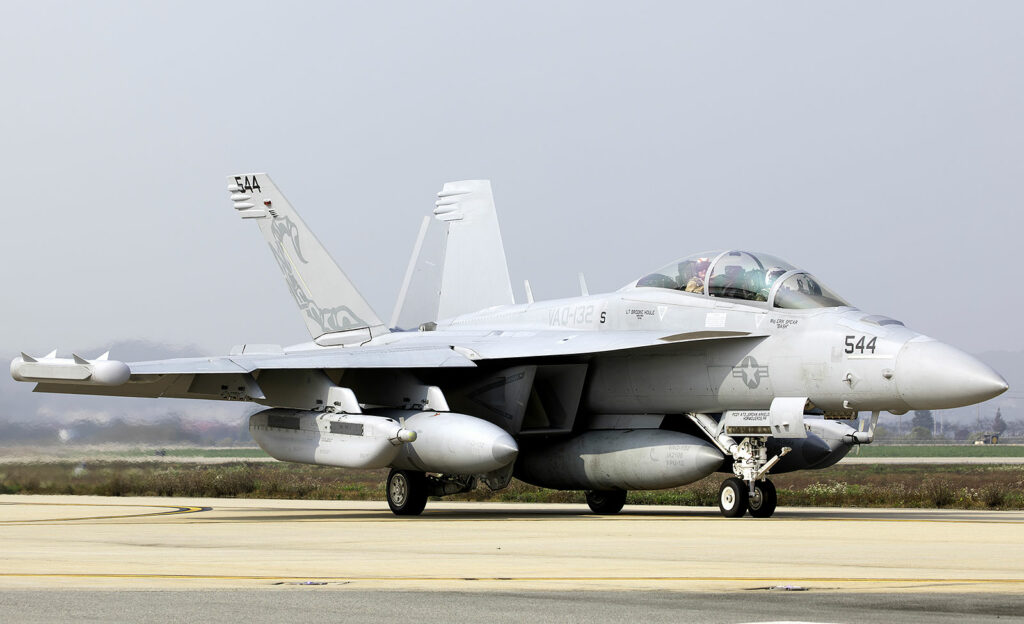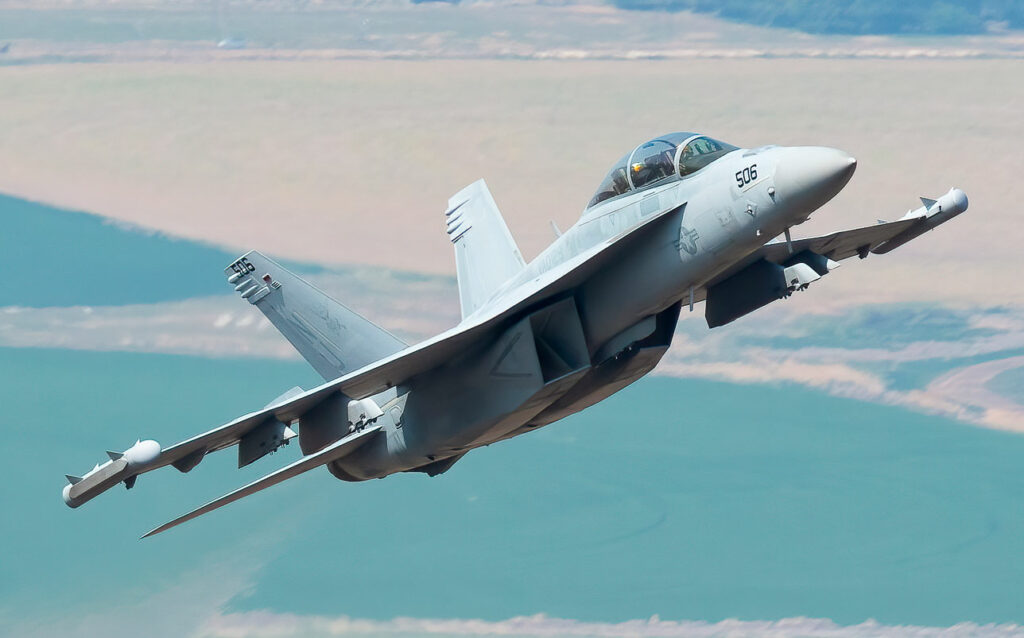Boeing EA-18G Growler – A twin-engine, carrier-based electronic warfare aircraft, designed for radar and communications jamming.
In brief
The Boeing EA-18G Growler is a specialized electronic warfare aircraft, built upon the F/A-18F Super Hornet platform. Developed by Boeing for the U.S. Navy, it serves a unique role in disrupting enemy radar and communications. The Growler is equipped with ALQ-99 jamming pods and the AN/APG-79 AESA radar, enabling it to perform offensive and defensive missions. It has a top speed of Mach 1.8 and a range of 1,275 miles (2,051 km), with a maximum altitude of 50,000 feet (15,240 meters). The aircraft is powered by two GE F414-GE-400 turbofan engines, generating a combined 44,000 pounds (19,958 kg) of thrust. These features enable the Growler to accompany strike packages and protect both air and ground forces, making it an integral part of the U.S. Navy’s electronic warfare operations.

The Boeing EA-18G Growler
The Boeing EA-18G Growler is a powerful electronic warfare aircraft that has become essential to the U.S. Navy’s fleet. It is primarily tasked with electronic attack, employing jamming and deception tactics to protect friendly forces and ensure mission success. The aircraft offers a unique blend of speed, range, and advanced electronics, derived from the versatile F/A-18F Super Hornet design. Since entering service, the Growler has proven its capabilities in a variety of conflict zones, where electronic warfare plays a critical role in modern military strategy.
History of Development
The development of the Boeing EA-18G Growler began in the early 2000s, during a period marked by rapid advancements in electronic warfare technologies. With the EA-6B Prowler reaching the end of its operational life, the U.S. Navy recognized the need for a new platform that could keep up with evolving threats. The Growler program was officially initiated in 2003 as a solution to address these electronic warfare challenges and fulfill a critical role within the Navy’s air wings.
Boeing was awarded the contract to develop the EA-18G, utilizing the established F/A-18F Super Hornet as a base. This decision helped streamline production, as the Super Hornet’s design was already proven, highly reliable, and adaptable to the demands of electronic warfare. The first Growler prototype was rolled out in 2006, and the aircraft took to the skies for the first time on August 15, 2006.
The EA-18G entered service with the U.S. Navy in 2009. Known as “Growler,” it retained the same basic structure as the Super Hornet, but with significant modifications to incorporate electronic warfare capabilities. Unlike the traditional fighter roles of its predecessor, the Growler was specifically engineered for tasks like radar jamming, communication disruption, and countering enemy air defenses.
With the Cold War long over, the early 21st century presented new and diverse threats, particularly from asymmetric warfare and increasingly sophisticated enemy air defenses. The Growler was designed to meet these challenges by providing a platform capable of suppressing and disabling enemy radar systems, creating a safer environment for friendly aircraft and ground troops.
Design
The EA-18G Growler’s design is fundamentally based on the F/A-18F Super Hornet, though with modifications tailored to electronic warfare. It has a length of 60.2 feet (18.3 meters) and a wingspan of 44.8 feet (13.65 meters). The maximum takeoff weight is 66,000 pounds (29,937 kg). Two General Electric F414-GE-400 turbofan engines propel the aircraft, providing 22,000 pounds (9,977 kg) of thrust per engine.
One of the primary distinctions between the Growler and the Super Hornet is the integration of the ALQ-99 jamming pods, which are mounted on the aircraft’s wingtips and under the fuselage. These pods enable the Growler to disrupt enemy radar and communications, offering significant electronic attack capabilities. Additionally, the aircraft is equipped with the AN/ALQ-218 receiver system, which provides threat detection and situational awareness, enhancing its ability to locate and identify electronic signals.
The Growler’s advanced electronic capabilities give it distinct advantages in electronic warfare. However, the addition of electronic equipment has added weight and reduced the aircraft’s internal fuel capacity, which slightly limits its range compared to the Super Hornet. To counteract this, the Growler can carry external fuel tanks, which extend its operational range.
Performance
The EA-18G Growler is capable of achieving speeds of up to Mach 1.8 (approximately 1,190 mph or 1,915 km/h) at altitude, making it one of the fastest electronic warfare aircraft in service. It operates at a service ceiling of 50,000 feet (15,240 meters), providing it with a high-altitude advantage for electronic surveillance and jamming operations. The Growler’s combat range is approximately 1,275 miles (2,051 km) without external fuel tanks, though this can be extended by aerial refueling or adding external tanks.
The aircraft is powered by two GE F414-GE-400 turbofan engines, each producing 22,000 pounds (9,977 kg) of thrust, for a combined total of 44,000 pounds (19,958 kg). This level of thrust allows the Growler to reach its top speed rapidly, even while carrying the heavy electronic warfare equipment.
When compared to other electronic warfare aircraft, the Growler holds a strategic advantage due to its versatility and integration with carrier-based operations. For example, the Russian Su-34, while equipped for similar missions, lacks the carrier capability, limiting its operational flexibility. The Growler’s radar jamming capabilities are highly advanced, giving it an edge in modern electronic warfare by disrupting enemy air defenses and allowing strike aircraft to operate with greater freedom.
Variants
The EA-18G Growler has limited variants, with the primary difference being between the U.S. Navy’s standard version and an export variant offered to Australia. The EA-18G Export, used by the Royal Australian Air Force, is essentially the same as the U.S. version, though it includes some modifications tailored for interoperability with Australian forces.
While there have been no significant additional variants, the Growler’s capabilities have been incrementally upgraded over the years. These upgrades primarily focus on enhancing electronic warfare systems, improving jamming effectiveness, and increasing situational awareness through better detection systems. Despite the lack of multiple distinct variants, the Growler’s adaptability and incremental upgrades have allowed it to remain a potent asset.

Military Use and Combat
The EA-18G Growler has been actively used in various conflicts, providing critical support in both offensive and defensive roles. It is equipped with AGM-88 HARM missiles for radar suppression, along with AIM-120 AMRAAM and AIM-9 Sidewinder missiles for self-defense. The Growler’s primary mission is electronic attack, where it disrupts enemy radar systems and communication networks to protect friendly aircraft and ground forces.
One of the most notable deployments of the EA-18G was during Operation Odyssey Dawn in 2011, where it supported NATO-led airstrikes in Libya. The Growler played a key role in suppressing Libyan air defenses, creating a safer operating environment for allied aircraft. Its ability to jam radar systems significantly reduced the risk to other aircraft, enabling them to conduct strikes with reduced threat from surface-to-air missiles.
The Royal Australian Air Force also operates the Growler, which has participated in joint exercises with U.S. forces, demonstrating its interoperability and effectiveness in multinational operations. The Growler continues to be a crucial part of the U.S. Navy’s fleet, and with ongoing upgrades, it remains a formidable electronic warfare platform.
Currently, the EA-18G Growler remains in active service with both the U.S. Navy and the Royal Australian Air Force. It is likely to remain in operation until a suitable replacement is developed, though no immediate plans for replacement have been announced.
Back to the Fighter Jet section.